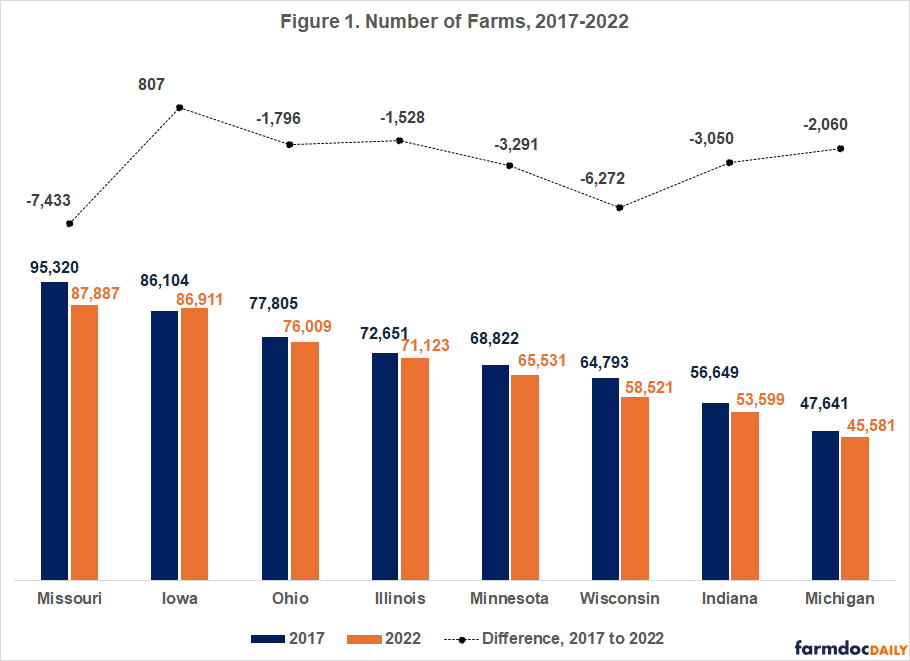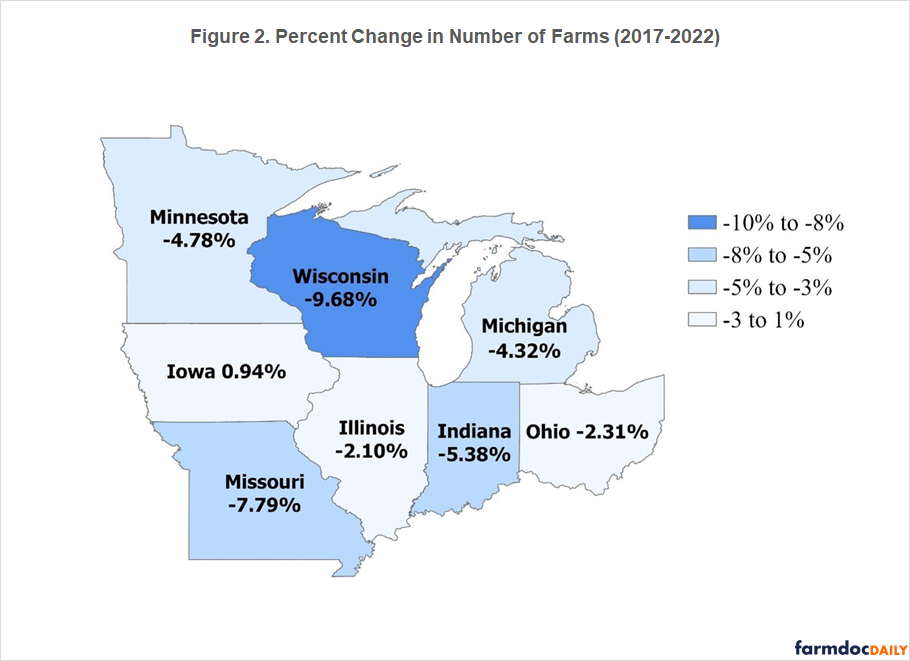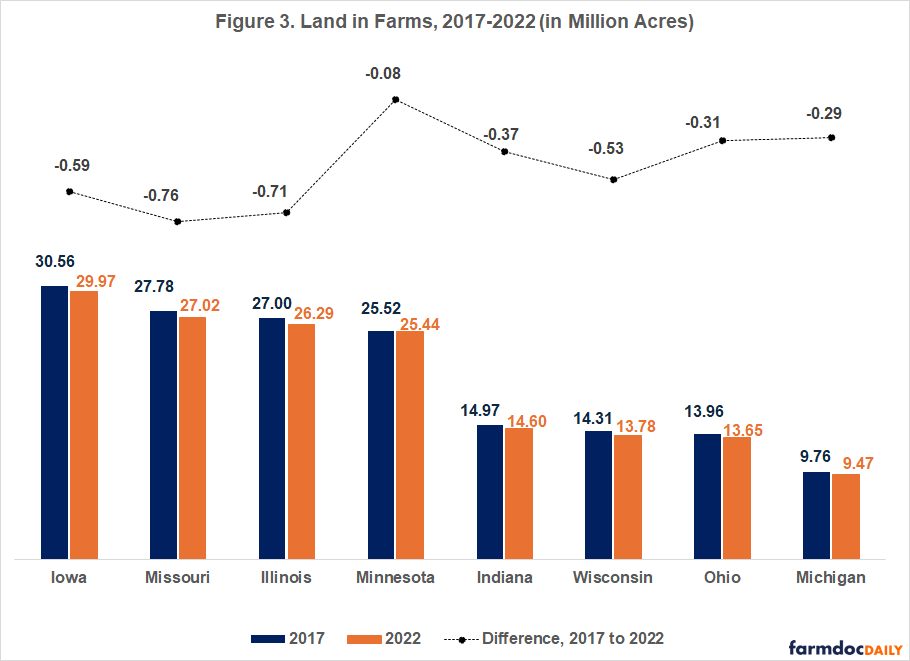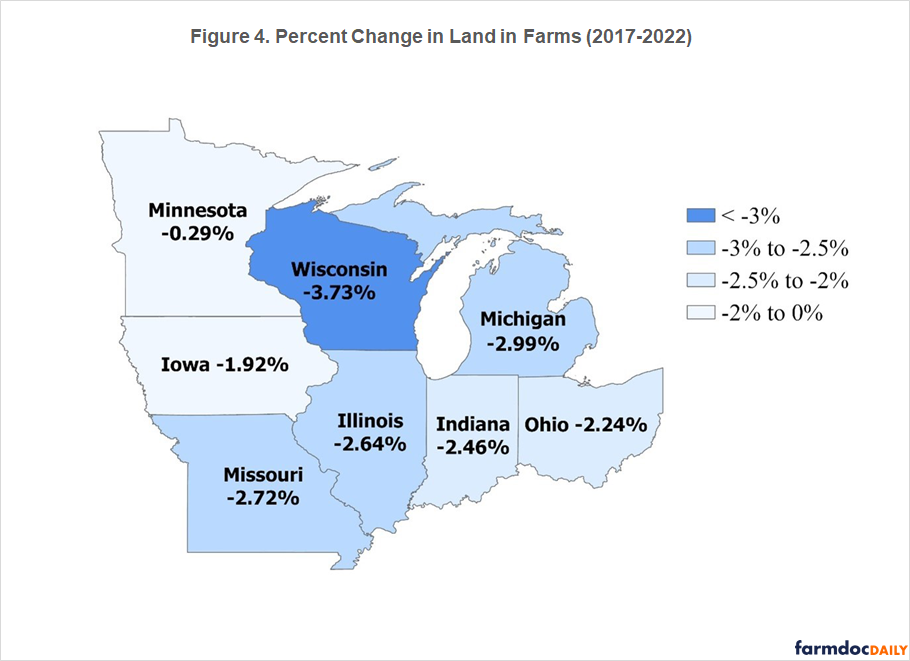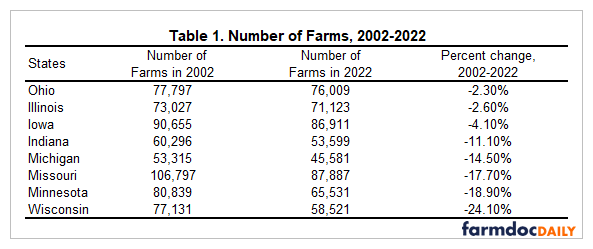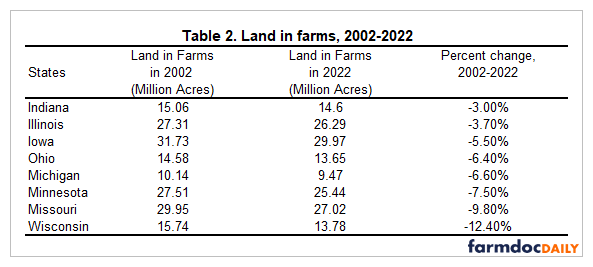Number of Farms and Land in Farms in the Midwest
The Census of Agriculture, which is conducted every five years by the US Department of Agriculture (USDA), provides a comprehensive picture of U.S. farms and ranches. Using data from the 2017 and 2022 Censuses, we examine the recent trends in the number of farms and land in farms across several Midwestern states. For the purposes of this analysis, we include 8 states in this geographical area: Illinois, Indiana, Iowa, Michigan, Minnesota, Missouri, Ohio, and Wisconsin. The 2022 Census confirms that the 21st Century decline in number of farms and land in farms in these states continues.
Definitions used by Census of Agriculture
The Census of Agriculture defines a farm as “any place from which $1,000 or more of agricultural products were produced and sold, or normally would have been sold, during the year.” This definition has been used consistently since 1974. “Land in farms” is defined as “primarily, agricultural land used for crops, pasture, or grazing, including woodland and wasteland that are part of the farm operation but not actively cultivated or grazed; as well as acres in the Conservation Reserve Program, the Wetland Reserve Program, and other government conservation programs.” Therefore, land in farms is a broader definition than cultivated land.
Number of Farms, 2017-2022
Except for Iowa, each of the eight states examined in this article experienced a decline in the number of farms between the Census of Agriculture for 2017 and 2022 (Figure 1). Number of farms in Iowa increased by 807. Illinois experienced the smallest decline, from 72,651 to 71,123, with 1,528 fewer farms over the five-year period. The largest reduction occurred in Missouri, a decline of 7,433 farms. Missouri also had the highest number of farms in both 2017 (95,320) and 2022 (87,887). Michigan had the fewest number of farms, 47,641 and 45,581 in 2017 and 2022, respectively; for a decline of 2,060 farms.
In terms of percent change in the number of farms between 2017 and 2022, the decline was largest for Wisconsin (-9.68%) and smallest for Illinois (-2.10%) (see Figure 2). Iowa had a modest increase in the number of farms of 0.94%.
Land in Farms, 2017-2022
Iowa had the highest land in farms in 2022, followed by Missouri, Illinois, Minnesota, Indiana, Wisconsin, Ohio, and Michigan (see Figure 3). The range was from 29.97 to 9.47 million acres. All eight Midwest states had fewer acres in 2022 than in 2017. The range of decline was -0.76 million acres (Missouri) to -0.08 million acres (Minnesota).
The two largest percent declines in land in farms were -3.73% (Wisconsin) and -2.99% (Michigan). The two smallest were -0.29% (Minnesota) and -1.92% (Iowa).
Percent Change in the 21st Century
The trends during the 21st Century are also of interest since we are nearly a quarter of the way through the 21st Century. We examine the number of farms and land in farms in the 2002 and 2022 Census of Agriculture and then compute the percent change over the last 20-year period. We also compare them with the percent changes between the 2017 and 2022 Censuses of Agriculture.
Over the 20-year time period from 2002 to 2022, percent change in number of farms ranged from -2.3% (Ohio) to -24.1% (Wisconsin) (Table 1). For land in farms, the range was -3.0% (Indiana) to -12.4% (Wisconsin) (Table 2).
In general, the percent decline was larger over the longer period. Average percent decline in number of farms across the eight states was 11.91% for 2002-2022 vs. 4.43% for 2017-2022. Average percent decline in land in farms was 6.86% for 2002-2022 vs. 2.38% for 2017-2022. Moreover, there was only one positive percent change over either period, number of Iowa farms over the 2017-2022 period (+0.94%). No east-west or north-south pattern is obvious among the eight states.
Discussion
The 2022 Census of Agriculture finds that 2017-2022 period continued the on-going 21st Century decline in number of farms and land in farms in US Midwestern states. These trends confirm the concern among agricultural stakeholders and policymakers regarding declining number of farms and land in farms; however, this concern has not yet coalesced into a policy issue on the national and farm bill agendas.
Reference
USDA National Agricultural Statistics Service. (2022) Census of Agriculture: available at https://www.nass.usda.gov/Publications/AgCensus/2022/#full_report
Disclaimer: We request all readers, electronic media and others follow our citation guidelines when re-posting articles from farmdoc daily. Guidelines are available here. The farmdoc daily website falls under University of Illinois copyright and intellectual property rights. For a detailed statement, please see the University of Illinois Copyright Information and Policies here.








